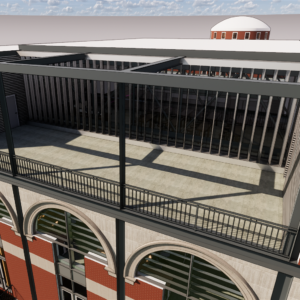
VIRTUAL DESIGN
Utilizing Extended Reality in the architectural design process allows for a freedom of creativity as well as a grasp of advancing technology. Through experiential design, we can improve our designs with rapid iteration, collaboration, and ultimately create greater value in the design process.
As I investigate the processes of working with extended reality in design, I’ve chosen Alumni Hall in Oxford, Ohio as a proof of concept case study. The images below are links to several viewers that represent preliminary work for my thesis design. The work seen in these views was primarily designed using extended reality systems.



Warning: heavy graphics load
Promoting Patrimonial Tourism of the Ancient Kingdom of Kush, as a means to rejuvenate the Economy of Sudan
In the Sudan, decreasing economic viability has depleted the country’s capital resources resulting in poverty, unemployment, and inequitable opportunities for its citizens. The paper discusses the following question: can architectural strategies supporting patrimonial tourism of the ancient African kingdom of kush, assist in rejuvenating the economy of Sudan?
To address this question, the following case studies are discussed: The Adrère Amellal Oasis project in the Siwa Oasis at the western desert of Egypt. Sudan and its bordering country Egypt, shares history and resources, and the project translates through architecture, how economic sustainability can be introduced into harsh environments through the hospitality industry. At the same time, the tourism of Sudan’s regional neighbor Uganda will be reviewed as an economic analysis of the impact of tourism on Uganda. While to better understand the impact of the build environment on an international level, the Boston Freedom Trail will be analyzed as a visual application at an urban scale, which connects historical tourist attractions. These examples have similarities in different aspects that can be abstracted to applicable input in Sudan.
A brief overview of the history of Sudan is offered to present the kush kingdom and related tourism attractions with relevant data. Economic based theories can be used to strategize the investment on the short and long term, to address how patrimonial tourism can help save the economy of Sudan. For example, contributions in hospitality and cottage industries, which can be reflected through modern and vintage textile fabrics weaving techniques created within the community, will enhance the overall experience of tourism. In addition, weaving techniques can be translated to architectural facades. The goal of this paper’s inquiry is to propose an architectural design that can reflect the identity of a culture, and to enhance Sudan’s economy through patrimonial tourism.
Pushing the Envelope
here we go
Open for business.


